Curing soap near windows exposes it to harmful UV rays that fade colors and weaken fragrances. Windows create temperature fluctuations that disrupt saponification, potentially causing "alien brains" or uneven colors. You'll also face increased humidity that extends curing time and attracts dust particles that compromise quality. Position your curing racks in a cool, consistent environment away from windows with gentle airflow for ideal results. The perfect curing environment leads to superior soap with longer-lasting properties.
The Sunlight Effect: How UV Rays Damage Curing Soap
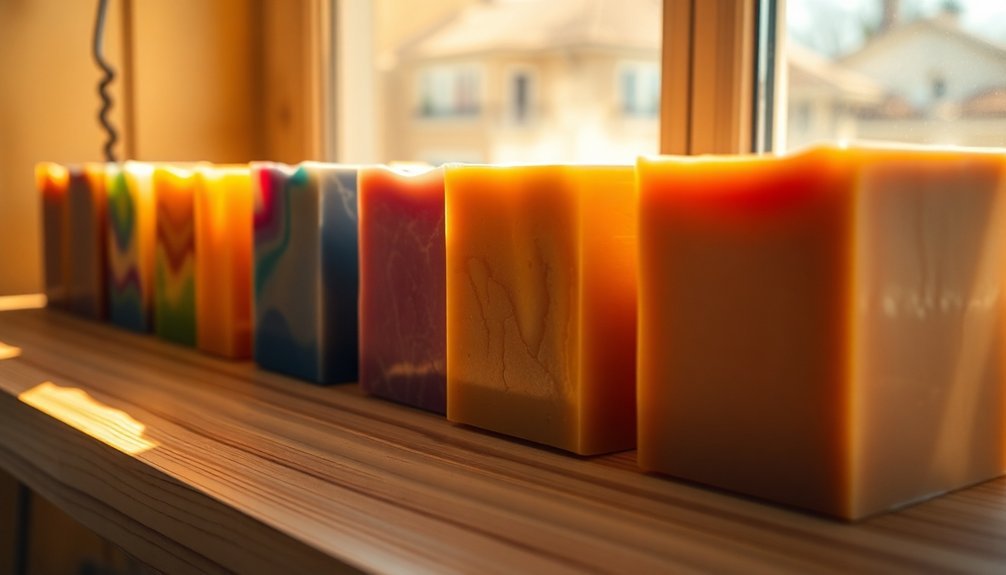
While you might be tempted to place your freshly made soap bars near a sunny window, ultraviolet rays can cause significant damage during the curing process.
UV light quickly fades both natural and synthetic colors in your soap, leaving you with an unappealing, discolored product that doesn't match your original design.
Unwanted color shifts happen quickly with UV exposure, turning vibrant designs into pale disappointments.
Beyond aesthetics, sunlight degrades essential oils, diminishing both their therapeutic properties and fragrance. Your carefully selected scents will weaken prematurely, even with UV-resistant pigments.
UV exposure also affects your soap's performance by altering its molecular structure. This can compromise lathering properties and cause your bars to become dry and brittle. Optimal curing requires temperatures between 60°F to 80°F for best results, which windows often exceed.
Unlike beneficial curing changes that enhance durability, UV damage only deteriorates quality. For ideal results, always cure your soap in a dry, well-ventilated area away from direct sunlight.
Temperature Fluctuations and Their Impact on Soap Quality
Temperature fluctuations represent another significant risk when curing soap near windows. The saponification process is naturally exothermic, releasing heat that must be carefully managed for ideal results.
When your soap is exposed to inconsistent temperatures near windows, this delicate balance is disrupted. The reaction between triglycerides and sodium hydroxide continues throughout the curing process, albeit at a slower rate.
Windows allow rapid heating during sunny periods and cooling at night, interfering with proper gel phase development. These inconsistencies can lead to unwanted aesthetic issues like "alien brains," soda ash formation, and uneven color distribution throughout your bars.
Your soap's hardness, lather quality, and overall performance are also compromised when temperature varies unpredictably.
For high-quality soap, you'll need a stable curing environment away from windows where temperature remains consistent, ensuring your product achieves uniform texture, appearance, and functional properties.
Humidity Concerns: Why Moisture Near Windows Affects Curing
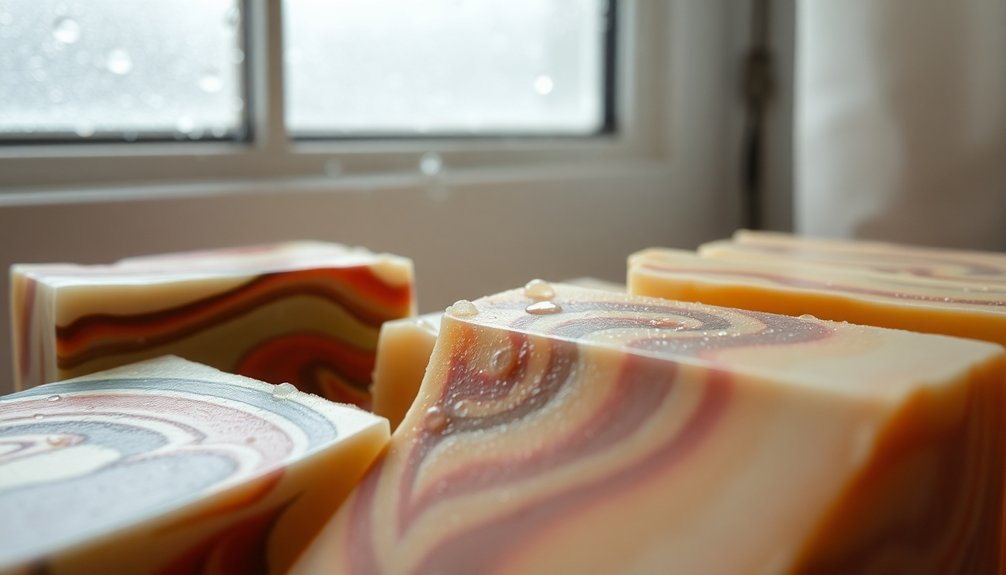
Three significant humidity challenges arise when curing soap near windows.
First, windows create localized areas of higher humidity due to air exchange, particularly during rainy seasons or in humid climates. This excess moisture slows water evaporation from your soap, extending curing times well beyond normal ranges. Increased humidity prolongs the curing time of cold process soap, sometimes requiring weeks longer than expected in drier conditions.
Windows invite unwanted humidity, creating wet microclimates that trap moisture in soap, prolonging cure times dramatically.
Second, this moisture can cause your soap to "sweat," creating unattractive beads of water on the surface. While this doesn't affect functionality, it diminishes aesthetic appeal and may deter potential customers.
Third, high humidity increases the risk of mold development, especially in soaps containing botanical ingredients.
You'll need to implement mitigation strategies like running a dehumidifier, using desiccants, or relocating your curing area away from windows. Regular weight checks will help you determine when your soap is fully cured despite challenging humidity conditions.
Dust and Pollutants: The Window-Adjacent Contamination Problem
Windows present another significant challenge for soapmakers beyond humidity concerns: unwanted contamination. Your carefully crafted soaps can quickly become dust magnets when placed near windows, where electrostatic charges attract particles and airflow increases dust circulation.
When you cure soap by windows, you're exposing it to a cocktail of outdoor pollutants—PM2.5, NO2, ozone, and even microplastics—that can settle on your soap's surface. These contaminants don't just affect appearance; they can potentially react with and degrade your soap ingredients, rendering products unsellable.
To protect your creations, use HEPA filters in your curing area, keep windows closed during high pollution periods, and cover soap with breathable cloth. Direct sunlight exposure can also fade colors and fragrances of your beautiful handcrafted soaps.
Better yet, find a dust-free location away from windows altogether to guarantee your soaps remain pristine throughout the curing process.
Creating the Ideal Curing Environment for Handmade Soap
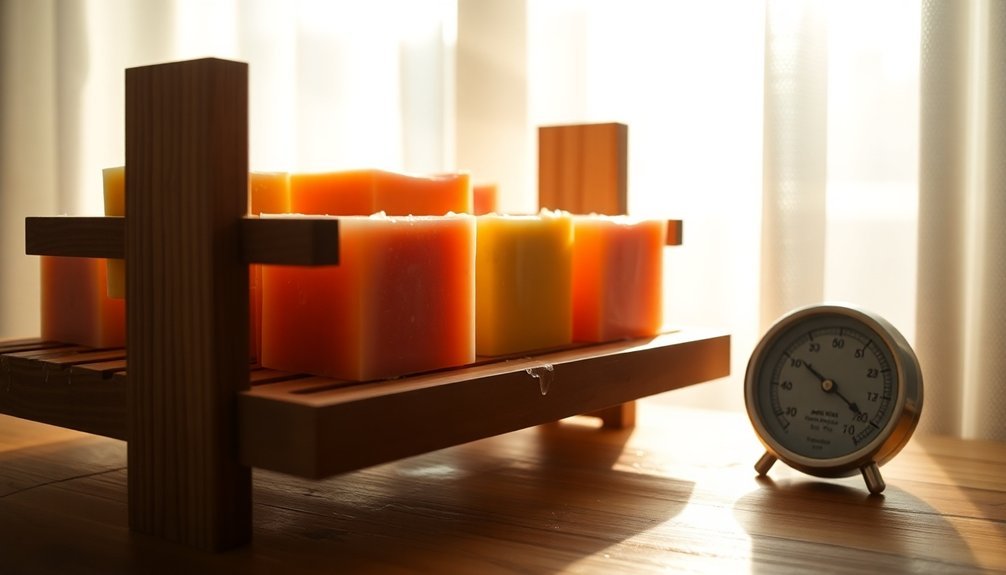
Creating the perfect curing setup requires you to position racks away from windows while ensuring consistent airflow around each soap bar.
You'll need to maintain a cool temperature between 60-70°F throughout the curing period, as fluctuating heat can compromise your soap's quality.
Consider using fans to circulate air effectively, but don't place them so close that they cause uneven drying or excessive airflow on your carefully crafted bars.
Proper curing environments help prevent dreaded orange spots from developing, which can occur when soap is exposed to direct sunlight or excessive heat.
Perfect Airflow Setup
When designing your soap curing environment, establishing ideal airflow becomes the cornerstone of successful soap making. Set up your curing racks with bars arranged in single layers, ensuring each soap is fully exposed to circulating air. Use stainless steel racks rather than aluminum, which can react with lingering lye. The process of proper curing significantly improves your soap's hardness, longevity, and lather quality.
| Airflow Element | Function | Ideal Placement |
|---|---|---|
| Electric Fans | Enhance circulation | 3-4 feet from soap |
| Dehumidifiers | Reduce ambient moisture | Same room, corner position |
| Curing Racks | Support even drying | Center of room |
| Zeolite Rocks | Absorb excess humidity | Near soap racks |
| Air Purifiers | Minimize dust exposure | Opposite corner from fan |
Position your setup away from windows to avoid inconsistent airflow, humidity fluctuations, and potential exposure to sunlight and dust that could compromise your soap's quality.
Temperature Control Essentials
Maintaining the perfect temperature is critical for handmade soap curing, with the ideal range falling between 65°F and 75°F.
Windows create temperature fluctuations that disrupt this delicate balance, especially during seasonal changes or throughout the day.
When you place soap near windows, you're exposing it to thermal shock—the sudden temperature changes that can compromise quality and appearance.
Direct sunlight streaming through glass can rapidly heat your soap bars, causing uneven curing, color fading, and potential deterioration of fragrance oils.
Bars placed near windows may inadvertently experience gel phase which can alter the intended appearance of your soap if that wasn't your goal.
Instead, choose a cool, stable location away from windows, preferably with minimal temperature variation.
Consider using a thermometer in your curing area to monitor conditions.
Maintaining Color and Scent Integrity During the Curing Process
The integrity of both color and scent in handmade soaps can be dramatically compromised if you're not careful about your curing location.
Direct sunlight near windows triggers photochemical reactions that break down colorants, causing your vibrant creations to fade unpredictably. UV rays are particularly damaging, affecting some soap colorants more severely than others.
Your carefully selected fragrances aren't immune either. Essential oils and fragrance compounds rapidly evaporate when exposed to air and sunlight near windows. While many soapers find that fresh air circulation is beneficial during the curing process, direct window exposure can be detrimental.
The heat accelerates oxidation processes, degrading scent compounds and diminishing the aromatic profile you've worked hard to create. Different fragrances may even interact negatively when subjected to these conditions, altering your intended scent completely.
For consistent results, cure your soaps in a controlled environment away from windows to preserve both visual appeal and aromatic character.
Alternative Placement Strategies for Proper Soap Curing
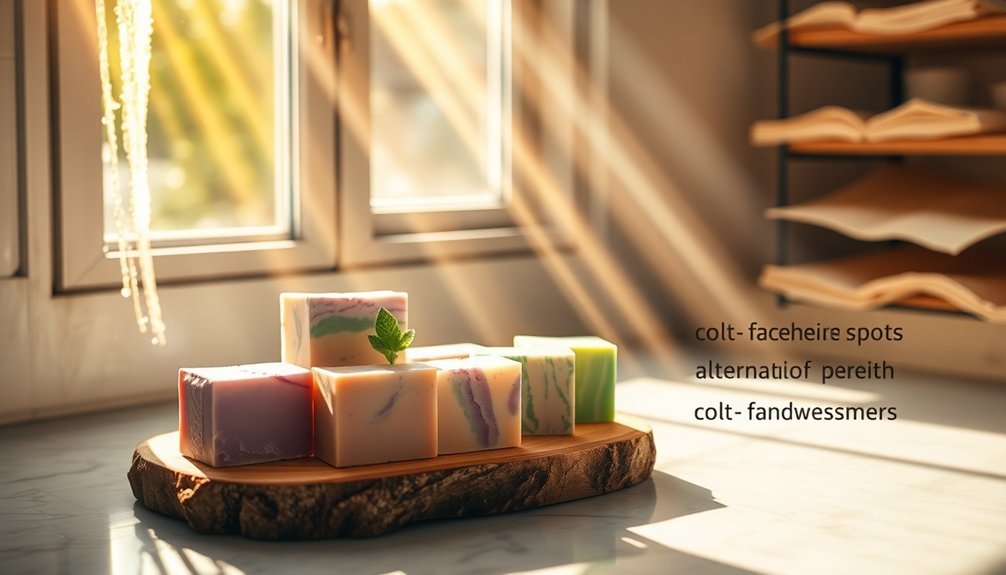
Finding ideal spaces for soap curing requires creativity beyond windowsills and sunlit corners. Consider using bookshelves or coated metal racks that maximize airflow while keeping your soap accessible.
Unlined cardboard boxes and stacked milk crates offer flexible storage solutions that absorb excess moisture. For efficient curing, arrange your bars horizontally with adequate spacing, or stack them vertically with air circulation between layers.
Think outside the soap box – cardboard containers and milk crates naturally wick away moisture while providing customizable arrangement options.
Line surfaces with greaseproof paper to prevent moisture transfer. Don't forget to rotate bars regularly for even drying.
In humid environments, use dehumidifiers or air conditioning to maintain a stable curing atmosphere. The proper curing process typically takes 4-6 weeks for cold process soaps to reach optimal performance and mildness. Ceiling fans can enhance circulation in larger spaces.
Wherever you choose, make certain your curing station is away from windows to avoid temperature fluctuations and direct sunlight exposure.
Frequently Asked Questions
How Long Does Soap Need to Cure if Placed Near Windows?
Soap near windows may take 4-6 weeks to cure, but you'll likely get inconsistent results. Temperature fluctuations, direct sunlight, and humidity changes can extend cure time or damage your soap's quality.
Can I Use a Windowsill if I Cover the Soap Completely?
Covering your soap on a windowsill doesn't solve all issues. You'll still face inconsistent temperature, potential humidity problems, and limited air circulation. It's better to choose a stable, well-ventilated location away from windows.
Will Essential Oils Evaporate Faster Near Windows?
Yes, your essential oils will evaporate faster near windows due to increased heat, light exposure, and air circulation. The temperature fluctuations and UV light also degrade their chemical composition and effectiveness more quickly.
Does Window Tinting Provide Adequate Protection for Curing Soap?
No, window tinting doesn't provide adequate protection for curing soap. It's primarily designed to block UV rays, not chemical vapors. You'll still need proper ventilation when curing soap regardless of window treatments.
How Do Seasonal Changes Affect Window-Adjacent Soap Curing?
Seasonal changes near windows create temperature fluctuations, humidity shifts, and varying sunlight exposure that'll disrupt your soap's curing process. You'll face inconsistent drying times and potential quality issues throughout different seasons.
In Summary
You'll find that avoiding windows during soap curing protects your hard work from UV damage, temperature swings, excess humidity, and airborne contaminants. Instead, choose a stable, dark environment away from direct sunlight where your soap can properly harden and develop. This simple step preserves your soap's color, scent, and quality, ensuring your handcrafted bars reach their full potential before use.

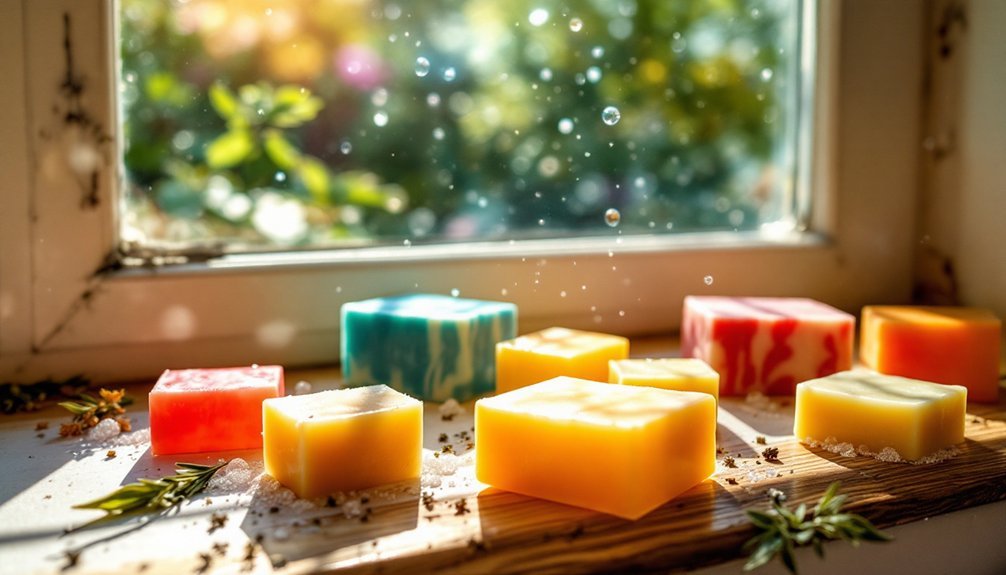



Leave a Reply